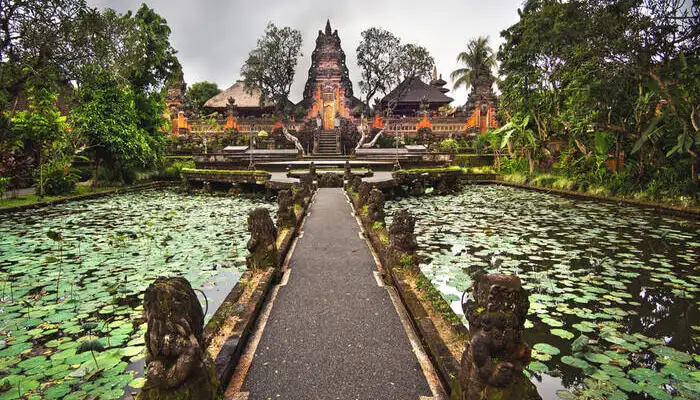Located in the heart of Ubud, Bali, the Ubud Palace, also known as Puri Saren Agung, stands as a testament to the rich cultural heritage and royal history of the region. With its ornate architecture, majestic courtyards, and vibrant cultural activities, the palace offers a fascinating glimpse into Bali’s past and present.
Ubud Palace serves as the official residence of the royal family of Ubud Bali, who have played a pivotal role in preserving and promoting Balinese art, dance, and culture. Stepping into the palace grounds is like entering a realm where tradition and beauty converge. The palace’s architecture, adorned with intricate carvings and delicate detailing, reflects the grandeur and elegance associated with Balinese royalty.
History: Tracing the Legacy of Ubud Palace
The history of Ubud Palace can be traced back to the 18th century when it was established as the residence of the royal family. Over the years, the palace underwent renovations and expansions, with each generation leaving its mark on the architecture and cultural legacy. The palace has also been a gathering place for artists, writers, and intellectuals, who have contributed to the cultural flourishing of Ubud.
Why Visit Ubud Palace?
Architectural Splendor
Ubud Palace showcases the intricate craftsmanship and architectural brilliance of Balinese artistry. From the ornate gateways and towering pagodas to the beautiful stone carvings and traditional Balinese designs, every corner of the palace exudes a sense of awe-inspiring beauty. Visitors can explore the palace’s various courtyards, pavilions, and gardens to appreciate the exquisite details that define Balinese architecture.
Cultural Performances
Ubud Palace is renowned for its vibrant cultural performances that take place regularly. Traditional Balinese dances, such as the Legong and Barong, are performed in the palace courtyard, providing an opportunity to witness the graceful movements and colorful costumes of these ancient art forms. The performances showcase the richness and depth of Balinese culture and are a must-see for anyone interested in the traditional performing arts.
Historical Significance
As the residence of the Ubud royal family, the palace holds immense historical significance. Exploring the palace allows visitors to delve into the royal heritage and gain insights into the customs, traditions, and governance of Bali’s past. Admire the regal artifacts, family heirlooms, and historical photographs that provide glimpses into the lives of the royal family and the evolution of Ubud as a cultural center.
Gardens and Grounds
The palace is surrounded by lush gardens and serene courtyards that offer a peaceful respite from the bustling streets of Ubud. Take a leisurely stroll through the beautifully landscaped grounds, admire the meticulously manicured flora, and find a tranquil spot to relax and soak in the serene ambiance. The palace gardens provide a delightful escape and an opportunity to connect with the natural beauty of Bali.
Shopping and Local Crafts
Located near Ubud Palace are vibrant markets and craft shops where visitors can indulge in retail therapy and immerse themselves in the local arts scene. From traditional Balinese paintings and intricate wood carvings to handmade textiles and silver jewelry, Ubud is known for its thriving artisan community. Take a stroll through the nearby markets to discover unique souvenirs and support local craftsmen.
Cultural Immersion
Visiting Ubud Palace allows travelers to immerse themselves in the cultural fabric of Bali. Engage with locals, witness daily rituals, and participate in traditional ceremonies that often take place in the palace compound. The palace serves as a cultural hub, offering insights into Balinese customs, beliefs, and way of life.
Route and Location: Navigating to Ubud Palace
Ubud Palace is conveniently located in the center of Ubud, making it easily accessible for visitors. There are several routes you can take to reach this historical landmark:
- From Denpasar: If you are coming from Denpasar, the capital city of Bali, you can take a taxi or hire a driver to drive you directly to Ubud Palace. The journey typically takes around 1 hour, depending on traffic conditions. Make sure to communicate your destination clearly to the driver.
- From Ngurah Rai International Airport: If you are arriving at Ngurah Rai International Airport, you can hire a taxi or arrange for transportation services to take you to Ubud Palace. The drive from the airport to Ubud usually takes about 1.5 to 2 hours, depending on traffic.
- From Other Areas in Bali: If you are staying in other areas of Bali, such as Kuta, Seminyak, or Sanur, you can hire a driver or use ride-hailing services to travel to Ubud Palace. The duration of the journey will depend on the distance and traffic conditions.
What to See at Ubud Palace
Architecture and Design
The main attraction of Ubud Palace is its stunning architecture and design. Explore the palace grounds and admire the intricately carved gateways, ornate pavilions, and beautiful courtyards. Each structure showcases the exquisite craftsmanship and attention to detail that are characteristic of traditional Balinese architecture.
Traditional Performances
Ubud Palace is renowned for its traditional dance performances that take place in the evening. Witness the grace and beauty of Balinese dance forms, such as the Legong dance, Barong dance, or Ramayana ballet. These performances bring to life the rich cultural heritage and mythology of Bali.
Royal Courtyard
Step into the royal courtyard of Ubud Palace and feel transported to a bygone era. Adorned with statues, fountains, and beautiful landscaping, the courtyard offers a tranquil space to relax and appreciate the grandeur of the palace. Take a moment to sit and absorb the regal atmosphere.
Art Galleries
Within the palace complex, you’ll find art galleries that showcase the works of local artists. Browse through the paintings, sculptures, and other artistic creations that highlight the diverse art scene of Ubud. It’s a great opportunity to appreciate and support local artists.
Traditional Ceremonies
Depending on the timing of your visit, you may have the chance to witness traditional ceremonies taking place at Ubud Palace. Balinese ceremonies are colorful and vibrant, often accompanied by traditional music, offerings, and processions. These ceremonies provide a deeper understanding of Balinese spirituality and cultural practices.
Garden and Grounds
Take a leisurely stroll through the palace gardens and grounds, which offer a serene escape from the hustle and bustle of Ubud. Enjoy the well-maintained landscaping, beautiful flowers, and tranquil atmosphere. Find a peaceful spot to sit and reflect, surrounded by the natural beauty of the palace gardens.
Exploring Ubud
Ubud Palace is located in the heart of Ubud, so it serves as an excellent starting point for exploring the town. Take a walk along the nearby streets and explore the vibrant markets, art galleries, cafes, and shops that make Ubud a cultural hub of Bali. Discover local crafts, sample traditional Balinese cuisine, and immerse yourself in the artistic and spiritual vibes of the town.
Conclusion
Ubud Palace stands as a cultural landmark that preserves the legacy of Bali’s royal heritage and showcases the artistic traditions that have flourished in the region. With its stunning architecture, captivating performances, and immersive cultural experiences, the palace offers a glimpse into the rich tapestry of Balinese history and artistry.
Whether you are drawn to the architectural splendor, the vibrant performances, or the opportunity to connect with Bali’s cultural heritage, a visit to Ubud Palace is an invitation to delve into the cultural heart of Bali and discover the treasures it holds.




